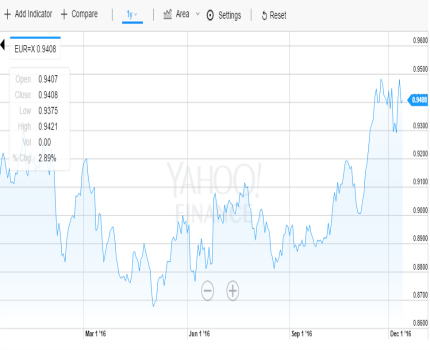
The Fed raised the interest rate by twenty five basis points from 0.5% to the new rate of 0.75%. This becomes the second rate hike in the past decade since the last one in December 2015 when the Fed raised the key interest rate from a near zero point which was initially set after the 2008 global financial crisis and the resulting recession. Although the hike in interest rate was highly expected from most quotas, the combined effect of the higher interest rates and the expected inflation rate of about 2% in 2017 set a new stage for currency trading with the increased expectation that the dollar will be strengthening against its global peers.
A report by Goldman Sachs predicted that the euro and the US dollar will reach parity sometime in the fourth quarter of 2017. However the US dollar will keep dominating the market in the first three quarters. Since president-elect Donald Trump won the US presidential elections, the US dollar has been on an upbeat mode, having risen about 4.4% against the euro over the one month period of time. Compared to a basket of other world currencies, the US dollar had risen about 2% against them all; which shows that the predicted strengthening of the greenback might be taking shape already. Immediately after the release of the information about the interest rate hike by the Fed Chairperson Janet Yellen, the greenback rose by about 0.5% against the euro to €0.9455; and by about 0.9% against the yen at 116.17 yen.
From an investor’s perspective, the proposed high expenditure on infrastructure development by the Trump administration coupled with the reduction in taxes; will both result to high domestic growth. Thiswill then be accompanied by high inflation due to the rise in money supply in circulation within the economy as a result of the government and private sector investment. With the growing inflation, investors then expect that the Federal Reserve will increase its interest rates in order to match the rising inflation and keep the economy in check all through as the Trump administration implements their expansionary fiscal policy. When asked to comment about the new incoming President, Ms. Yellen however declined to give a comprehensive answer saying that, "I'm a strong believer in the independence of the Fed. I am not going to offer the incoming president advice."

All else held constant, the rate hike did not come as a surprise to the markets, although the minimal mention of the current political issues when releasing the report caught many analysts’ attention. The fact that president-elect Donald Trump is planning to implement some unorthodox economic policy changes should play a big role in advising the monetary policy followed by the Fed. The Fed however seem to have factored in the predicted high inflation into their plans for 2017 to match the probable fall in the purchasing power of the dollar.
.jpg)






















